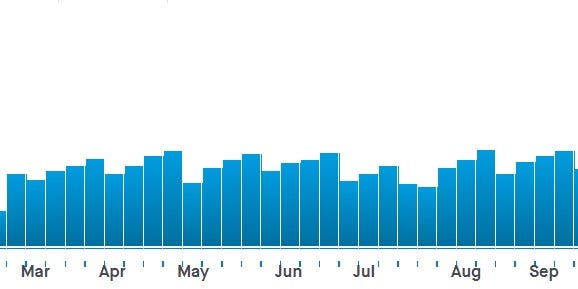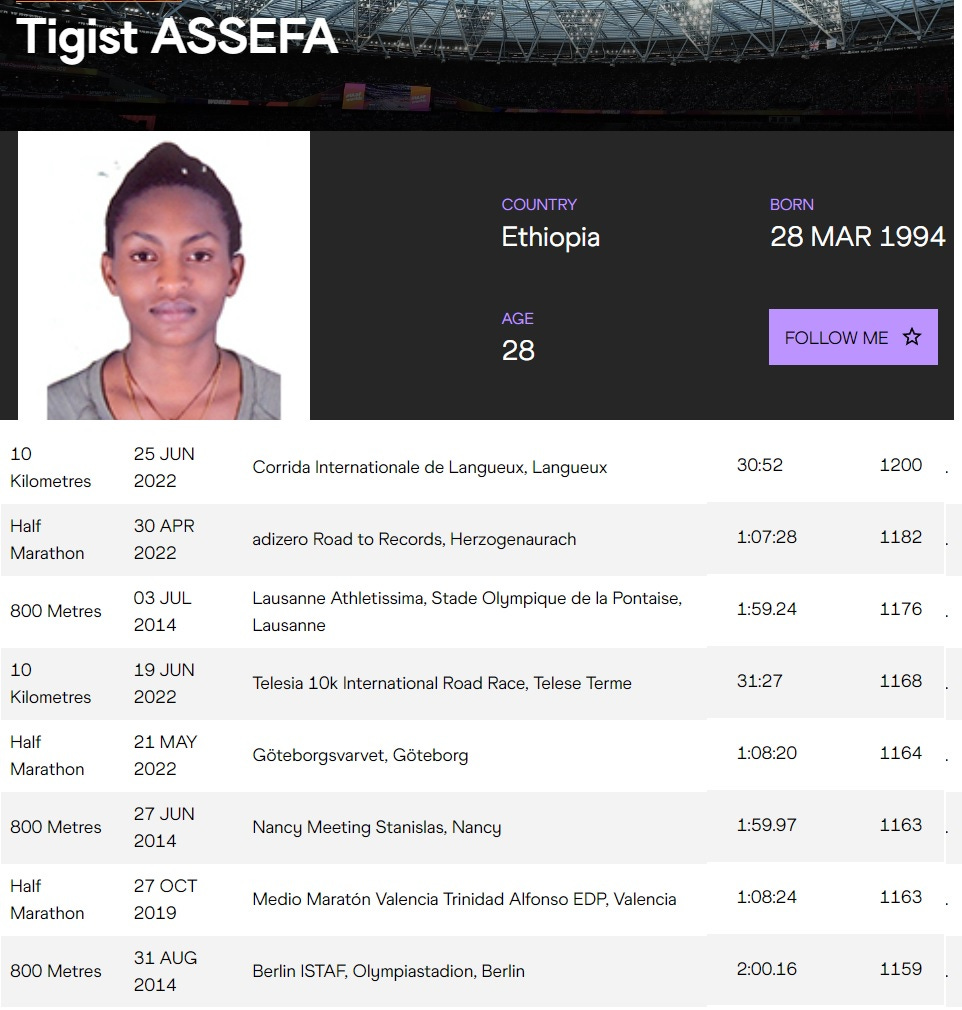The EPIC 2022 Berlin Marathon: HUGE spoilers in subtitle, share with caution!!!
Eliud Kipchoge runs a lopsided world record, while a sub-2:00 800-meter runner becomes the third-fastest female marathoner of all time
More bizarre than Eliud Kipchoge, approximate age 37, barreling through the halfway point of the Berlin Marathon this morning in 59:51 was that one of the four men with him was not a pacesetter. That was one of numerous unprecedented scenarios that a wonderfully fired-up crowd in Germany enjoyed and arguably helped produce today.
Kipchoge said in a post-race interview that he had planned to go out in 1:00:40 (“My legs were moving very fast,” he explained). Maybe that’s why Ethiopian Adamlak Belihu, personal best 2:09:43, stayed on his ass, with no one involved having access to a functioning timepiece. Belihu has a pair of sub-27:00 track 10,000s and a sub-59:00 half to his credit, but the pace was obviously absurd for absolutely anyone. It was a beautifully reckless display. Keep in mind that Ryan Hall is the only American to ever run a half-marathon faster than 59:51 (59:43 in 2007, placing Hall 165th all-time in the world today).
The pacemakers dropped out at 25K, at which point the leaders were projected to finish in a shade over two hours. Belihu started to cede ground despite the kilometer splits beginning to creep from the low 2:50s into the high 2:50s, but by this time only three other men in the field were even on sub-2:04:00 pace. The only question was whether Kipchoge would break his own world record (2:01:39) and not only draw the official record closer to the 1:59:40 Kipchoge has already run for the marathon distance in a partial vacuum, but also distance himself further from Kenenisa Bekele, whose 2:01:41 makes him the second-fastest marathoner of all time.
I was bantering with someone by chat during the race, which was streamed for free—sorry, FloTrack—on K24 Live (motto: “It’s what’s on”). I was fairly confident at one point that Kipchoge would miss his record. After running 5K splits of 14:32 and 14:30 between 25K and 35K, he slipped to a 14:43, which included a 3:03 klick. With a 40K split of 1:54:53, he would miss the record by running any slower than 3:05 per kilometer for the next six and a half minutes. Although this was Eliud Kipchoge, his race was trending that way. By taking a gamble in the first half and aiming for a sub-two—not his intent, as it turns out—he might narrowly miss his own world record.
But then Kipchoge reclaimed his one-of-a-kind sheen-and-bounce and just started picking up the tempo like he’d been taking a break to adjust his music player rather than struggling. He covered the last 1.367 miles of the marathon at 4:35 per mile pace, or just under 2:51 per klick. That brought him home in 2:01:09, a pace of 4:37.24 per mile. Hs 30K split of 1:25:40 was 2:37 1:37 under his own and Stanley Biwott’s official record for the distance, collected during the 2016 London Marathon en route to a 2:03:05 (then eight seconds outside Dennis Kimetto’s world record).
With splits of 59:51 and 1:01:18, Kipchoge clearly could have run significantly faster, but we* already knew this. What we now know is that there’s a good chance he could have run 2:00:30 today off a halfway split of 1:00:15-1:00:20. It must be nice to set a world record by a comfortable amount while running with such galactic inefficiency that another try by Kipchoge for yet another world record, if not a sub-two, seems almost inevitable.
Speaking of positive splits with positive (enough) results, Belihu somehow held on for a 2:06:40, covering the first half of the race in just under 4:34 pace and the second half in just under 5:06 pace. His 2:06:40 earned him—really earned him—fourth place. Oh yeah, Kipchoge won the race by 4 minutes and 49 seconds, which would literally have been a mile if not for the problem of time not being a unit of linear measure.
American Keira D’Amato was the pre-race media favorite among the women, but this may have been more aspirational than logical. True, she had the fastest personal best in the field, the American record 2:19:12 she ran in Houston in January. But as Jon Gault pointed out in his preview for Letsrun, there were five women in the field with recent times under 2:21, and two other entrants boasted sufficiently fast half-marathon times (1:05:34 and 1:06:17) to merit inclusion in the “favorites” conversation even if they were untested marathoners.
When American running fans look at a 2:19:12 by a woman, they see something far more remarkable than the rest of the world does. Coming into Berlin, two dozen women—All African-born, thirteen from Ethiopia and eleven from Kenya—had run faster than 2:19:12 in just the past five years. D’Amato, deep down, was probably uneasy in the role of prohibitive favorite.
Arguably, choosing her as the likely champion was racist. That’s what makes this article in The Washington Post so amusing. The shit they print about running in the WaPo and The New York Times is formulaic almost to the paragraph: Promote the idea that American women of today are at the forefront of something unprecedented, leading the charge from the professional working-class side; mention the days when women weren’t allowed to even run; argue that training methods have recently been revolutionized (again); and give a curt nod to “inclusion” for all the white readers who pretend to care about minorities. It’s all about creating the illusion that collective social progress has emerged from things like taking vicarious pleasure in the athletic exploits of a D.C-area realtor.
There was a reminder that everyone involved in the sport sucked before soccer moms saved it:
Professional running also feels different now, D’Amato said. Her first tour of professional running, immediately post-college, didn’t feel as like inclusive and supportive and encouraging as it does now, she said.
“I think that takes like a really like strong special person to be able to fight like tooth and nail, but then also have the utmost respect for all of the competitors,” she said.
The writer isn’t even trying here—D’Amato’s quote is a non sequitur, and it’s not her fault.
There was also this from the NAZ Elite’s Ben Rosario:
“There’s so much more science that’s involved now as opposed to 20 years ago when it was ‘go out and run as many miles as you can and puke in the trash can afterwards. Everything is very structured, it’s very calculated, it’s very purposeful. And that gives the athlete the mindset that I’m totally prepared and I can take huge risks because I am absolutely 100% ready.”
Rosario himself was training for marathons in the early 2000s and knows the part about nothing but mileage and puking in cans is nonsense. But he was obligated for this shitty story to not say anything that sounds like “Well, it’s not rocket science—being attentive to the purpose of every run is as important now as it was twenty and thirty years ago.” He’s also not Keira D’Amato’s coach or her druggist.
The article mentions supershoes so many times that the author seemed to think that hammering away at this would distract readers from wondering if maybe performance-enhancing drugs might be playing a role in some of this unlikely late-thirties success. After all, the last white American female running superstar who earned mass-media coverage only did so for being caught doping, though the media framed this as a food-truck meal gone more deeply into the shitter than normally occurs after such an indulgence.
In his Letsrun preview, Gault wrote:
The only thing that might give the uninformed observer pause is the fact that D’Amato ran a marathon in the middle of her buildup. How is someone going to go from running 2:23:34 at the World Championships in Eugene on July 18 (in ideal conditions, I might add) to more than four minutes faster two months later?
Since you’re reading LetsRun.com, you’re probably not an uninformed observer, but in case you forgot, D’Amato only had two weeks to prep for Worlds as she was a late replacement for the injured Molly Seidel.
I’d argue that D’Amato’s training is so monotonic at the level of training volume that it’s not as if two weeks of warning was apt to make her think “Oh poop, I haven’t been running enough.” Below is a graph of her weekly mileage since late winter from her Strava profile. I was too incompetent to capture the Y-axis, but she basically does four-week macrocycles of around 65, 75, 80, and 85 miles. This has been her pattern for some time. She’s averaging less than 10 miles a day for the year so far.
This morning, D’Amato set out as if to run under 2:19:00. Whether she expected it or not, over a dozen women set out ahead of her at sub-2:18:00 pace, with D’Amato hanging about 20 meters behind through 5K (16:25). Then the leaders sped up, as did D’Amato, still giving the leaders five to seven seconds through 10K (32:43). That put D’Amato, though in fourteenth place, on 2:18:02 pace. She was wise to hang back a little while trying to use the mass of leader-bodies to keep her on task, but this was too fast.
At halfway, D’Amato was in thirteenth with a 1:09:27 split, still on pace to break her record but with her splits trending a wee noxious. Six women ahead of her were on pace to run close to 2:16:30, with three others on schedule for about 2:17:00. Some of them would collapse, but even if D’Amato miraculously duplicated her first half, she was plainly going to be far out of sight of the leader the rest of the way.
At 30K, the lead pack was down to three, with the group on pace for 2:16-flat. In addition to never having seen a 2:06:40 off a sub-hour half, I don’t think I’ve seen a group of three women hit halfway in 1:08:13 and then accelerate that much, if at all. But that was too low-key, so Tigist Assefa ran a 15:46 5K (5:04 pace) starting 18.6 miles into the race and opened a 19-second lead on Tigist Abayechew. Assefa wound up running the third-fastest marathon ever by a woman, with her 2:15:37 trailing only Brigid Kosgei’s 2:14:04 and Paula Radcliffe’s 2:15:25. And she did it with a 1:07:24 second half that included a final 10K in around 32-flat. Three other women broke 2:19:00, but none broke 2:18:00.
Assefa twice broke 2:00 for 800 meters in 2014, when she was 20 years old. So what she did in Berlin was sort of like a 1:45 collegiate 800-meter guy banging out a 2:02 marathon at age 28.
Comfortably behind the leaders, D’Amato had moved up to tenth by 35K despite covering the previous 10K in 34:30 (5:33 pace, or 2:25:30 marathon pace). She climbed to eighth at 40K and passed two more runners to wind up sixth in 2:21:48, her second-best marathon. Splits of 1:09:27 and 1:12:21 aren’t pretty, but few American women besides her can run back-to-back 1:12:21 half-marathons. She appeared to stick to her plan despite the accelerating mob ahead of and around her and when the American record was as clearly out of reach as winning, she raced all the way until the end.
The announcer speculated afterward that D’Amato’s World Championships Marathon may have drained some of her reserves today. I doubt that. 2:23-2:24 in great weather and in supershoes shouldn’t be hard to recover from for a 2:19:12 runner, and no one seems to hint that the prolific marathon racing of Sara Hall, who’s older than D’Amato, poses a problem to Hall’s chances out there. Another mystery for another day.
Complete results of the men’s and women’s elite races in Berlin are here.


